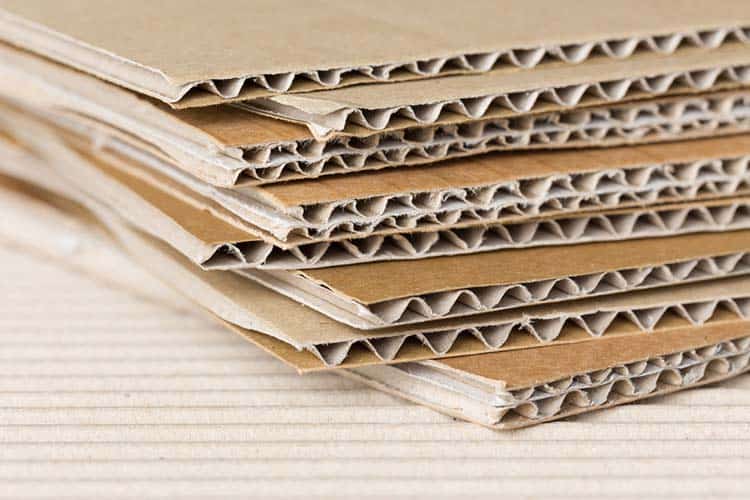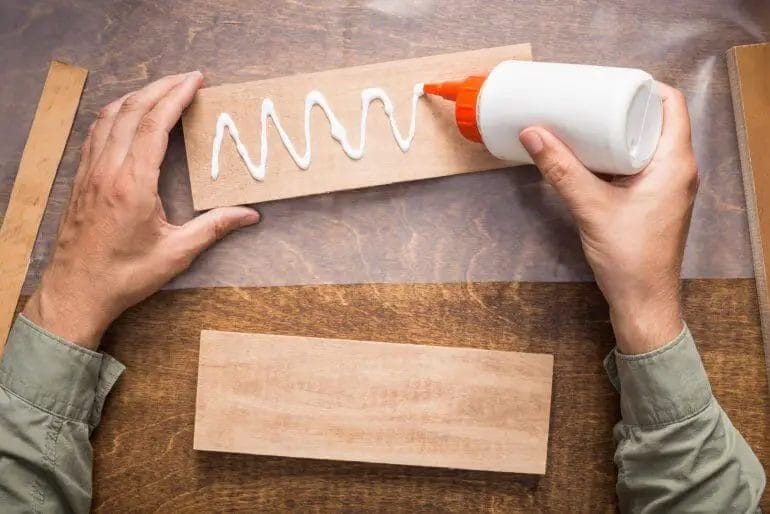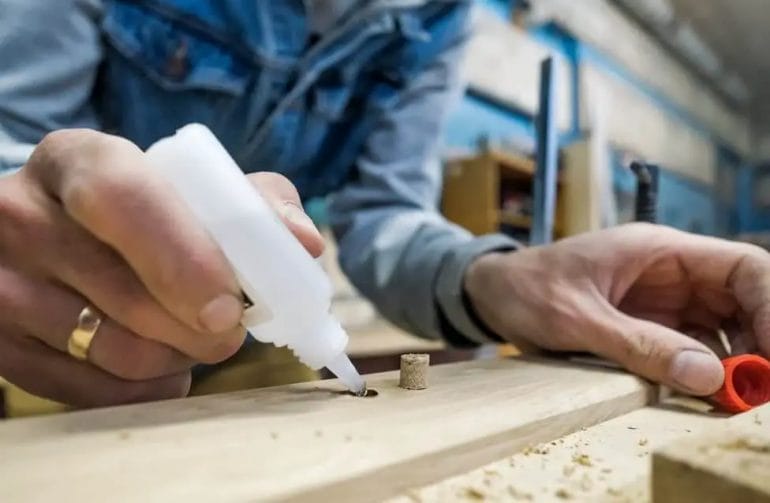Yes, wood glue can be used on cardboard for certain applications. Wood glue is a strong adhesive that forms a durable bond between materials, including cardboard. It is commonly used for crafts, repairs, and construction projects involving cardboard. However, it is important to note that the effectiveness of wood glue on cardboard may depend on factors such as the type of cardboard and the specific project requirements. It is recommended to choose a high-quality wood glue and follow the manufacturer’s instructions for best results.

The Benefits of Using Wood Glue for Cardboard Projects
When it comes to working on cardboard projects, using the right adhesive is crucial for ensuring a sturdy and long-lasting result. While there are various types of glue available, wood glue has proven to be an excellent choice for bonding cardboard. In this section, we will explore the benefits of using wood glue for cardboard projects.

1. Strong Bond
One of the primary benefits of using wood glue for cardboard projects is its ability to create a strong bond. Wood glue, also known as carpenter’s glue, is designed to provide an exceptionally strong adhesion on porous materials like wood and cardboard. Its unique formula allows it to penetrate the fibers of the cardboard, creating a bond that is difficult to break.
Unlike other adhesives that may weaken or lose their grip over time, wood glue maintains its strength even under pressure. This property ensures that your cardboard project remains intact, whether it’s a small model or a larger structure.
2. Versatility
Wood glue is not only effective for bonding wood but also works well on different types of materials, including cardboard. This versatility makes it a go-to adhesive for various craft and DIY projects. Whether you’re building a cardboard sculpture, a playhouse, or even repairing a damaged piece, wood glue can handle the job.
Its compatibility with different materials allows for greater flexibility in your creative endeavors. You can confidently use wood glue to join cardboard pieces together or attach other objects to your cardboard project.
3. Drying Time
Wood glue has a relatively fast drying time, which is advantageous when working on cardboard projects. It typically dries within 30 minutes to an hour, depending on the brand and environmental conditions. This quick drying time allows you to proceed with your project without wasting time waiting for the glue to set.
However, keep in mind that while wood glue may dry quickly on the surface, it may take up to 24 hours or more for it to fully cure. It’s essential to allow sufficient time for the glue to dry before subjecting your cardboard project to stress or movement.
4. Non-Toxic and Safe
Wood glue is generally considered safe to use, as most brands are non-toxic and solvent-free. This makes it an ideal choice for cardboard projects that involve children or when you want to avoid potentially harmful chemicals.
Furthermore, wood glue is water-based, making it easy to clean up with just soap and water. In case of accidental spills or excess glue, you can simply wipe it away without the need for harsh chemicals or solvents.
5. Affordable and Readily Available
Wood glue is a cost-effective adhesive option for cardboard projects. It is widely available in hardware stores, craft stores, and even online, making it easily accessible for any DIY enthusiast. With its affordable price tag, you can stock up on wood glue without breaking the bank.
Additionally, wood glue tends to have a longer shelf life compared to other adhesives, allowing you to use it for multiple projects over an extended period.
6. Sandable and Paintable
If you’re looking to achieve a smooth and polished finish on your cardboard project, wood glue is a great choice. Once the glue has fully cured, it becomes sandable, allowing you to sand down any rough edges or imperfections.
Furthermore, wood glue is paintable, meaning you can easily apply your desired paint or finish over the glued surface. This opens up a world of possibilities for customizing and enhancing the appearance of your cardboard creations.
Summary
Wood glue offers several benefits when used for cardboard projects. Its strong bonding capability, versatility, quick drying time, non-toxic nature, affordability, and sandability/paintability make it an excellent choice for any craft or DIY enthusiast. Whether you’re building intricate models, repairing damaged pieces, or creating decorative structures, wood glue is sure to deliver the results you desire.

Tips for Ensuring Strong Adhesion with Wood Glue on Cardboard
Wood glue is a versatile and effective adhesive that can be used for various woodworking projects. When working with wood glue on cardboard, it’s important to follow certain tips to ensure a strong bond and prevent any issues with adhesion. Whether you’re creating cardboard furniture, models, or crafts, these tips will help you achieve excellent results.
1. Choose the Right Wood Glue
Not all wood glues are suitable for bonding cardboard. It’s important to choose a wood glue that is compatible with cardboard materials. Look for a glue that specifically mentions it can be used on paper-based materials or cardboard.
One popular option is a PVA (Polyvinyl Acetate) wood glue, which is known for its strong bonding capabilities. It works well on cardboard and provides a durable bond when used correctly.
2. Prepare the Surfaces
Before applying the wood glue, it’s important to prepare the surfaces for optimal adhesion. Start by cleaning the surfaces to remove any dust, dirt, or debris that may hinder the bonding process. Use a clean cloth or a brush to gently wipe the surfaces clean.
Next, roughen the surface of the cardboard slightly. This can be done by using sandpaper to create a textured surface that allows the glue to grip better. Be gentle to avoid damaging the cardboard.
3. Apply the Glue Evenly
When applying the wood glue to the cardboard, ensure that you apply it evenly across the surface. Use a brush or a glue spreader to spread a thin layer of glue on both surfaces that need to be bonded.
Avoid applying too much glue, as excess glue can lead to a weak bond and seep out from the edges. A thin and even layer of glue is sufficient for a strong adhesion.
4. Allow Sufficient Drying Time
After applying the wood glue, it’s crucial to allow sufficient drying time for the adhesive to fully cure. Follow the manufacturer’s instructions for the recommended drying time, as it can vary based on the specific wood glue you are using.
During the drying process, ensure that the glued surfaces are held firmly together. You can use clamps or weights to help apply even pressure and prevent any shifting or separation.
5. Test the Bond
Once the wood glue has dried completely, it’s important to test the bond to ensure its strength and durability. Gently apply pressure on the bonded area to check for any signs of weakness or separation.
If the bond feels weak, consider reapplying the glue and repeating the drying process. It’s better to take the time to reinforce the bond than to risk a weak adhesion that may fail over time.
6. Consider Reinforcing with Other Materials
In some cases, it may be beneficial to reinforce the wood glue bond with additional materials. This can provide added strength and stability to the cardboard structure.
You can consider using masking tape or adhesive tape to secure the glued surfaces temporarily while the wood glue dries. This additional layer of reinforcement can help prevent any shifting or separation during the drying process.
Alternatively, you can also use small brads or nails to secure the cardboard pieces together before applying the wood glue. This can create a stronger bond, especially for heavier loads or structural applications.
In Summary
When working with wood glue on cardboard, choosing the right glue, preparing the surfaces, applying the glue evenly, allowing sufficient drying time, testing the bond, and considering additional reinforcement are crucial steps to ensure a strong adhesion. By following these tips, you can achieve excellent results and create sturdy and durable cardboard projects.

Alternative Adhesive Options for Joining Cardboard
Cardboard is a versatile material used in various industries for packaging, crafts, and display purposes. When working with cardboard, one of the key challenges is finding the right adhesive to join the pieces together. While traditional options like glue sticks and tape are commonly used, there are alternative adhesive options that offer unique benefits and can enhance the strength and durability of your cardboard creations.
Eco-friendly Adhesives
If you are conscious about the environmental impact of your projects, there are several eco-friendly adhesive options available. One such option is water-based adhesive. These adhesives are non-toxic, odorless, and do not release harmful fumes. Water-based adhesives also offer good bonding strength and are suitable for lightweight cardboard applications.
Another eco-friendly adhesive option is cornstarch adhesive. Made from natural ingredients, cornstarch adhesive is biodegradable and safe for children to use. It provides a strong bond and dries clear, making it ideal for both functional and aesthetic cardboard projects.
Double-Sided Tape
Double-sided tape is a popular adhesive option for joining cardboard due to its ease of use and convenience. This adhesive is available in various widths and thicknesses, allowing you to choose the right tape for your specific project needs. Double-sided tape provides a strong, permanent bond and is ideal for lightweight to medium-weight cardboard applications.
When using double-sided tape, ensure that the surface of the cardboard is clean, dry, and free from dust or grease for optimal adhesion. Simply cut the tape to your desired length, stick it to one piece of cardboard, and then press the second piece firmly onto the tape. The tape adheres instantly, eliminating the need for drying time.
Hot Glue
Hot glue is a versatile adhesive option that offers quick and strong bonding for cardboard. With a hot glue gun, you can easily apply the adhesive to the desired areas of the cardboard and join the pieces together. Hot glue bonds quickly and provides a durable connection, making it suitable for heavy-duty cardboard projects.
It is essential to exercise caution when working with hot glue to avoid burns. Additionally, hot glue may not be the best option for projects where the cardboard needs to be bent or flexed, as the adhesive may crack or become brittle.
Staples
For cardboard projects that require extra reinforcement, staples can be an effective adhesive option. Stapling the cardboard pieces together provides a strong and secure bond, making it suitable for heavy or structural applications. Stapling is particularly useful when working with thick or layered cardboard.
When using staples, ensure that you align the cardboard pieces correctly and use a staple gun or pliers to secure the staples firmly. Take care to place the staples at regular intervals to distribute the stress evenly and prevent the cardboard from warping or tearing.
Hook and Loop Fasteners
For projects that require frequent assembly and disassembly, hook and loop fasteners, commonly known as Velcro, offer a convenient and reusable adhesive option. Hook and loop fasteners consist of two parts: one with tiny hooks (the rough side) and the other with small loops (the soft side). When pressed together, these parts create a secure bond without the need for additional adhesives.
Hook and loop fasteners are ideal for interactive cardboard projects, such as pop-up displays or interactive books. They allow for easy repositioning and adjustment, making them suitable for applications where flexibility is needed.
Summary
When it comes to joining cardboard, there are several alternative adhesive options that can enhance the strength, durability, and functionality of your projects. Eco-friendly adhesives like water-based adhesive and cornstarch adhesive are ideal for those looking for environmentally conscious options. Double-sided tape provides a convenient and permanent bond, while hot glue offers quick and strong adhesion. Staples are suitable for heavy-duty applications, and hook and loop fasteners offer easy assembly and disassembly. Consider these alternative adhesive options to find the best solution for your specific cardboard project needs.
Creative DIY Cardboard Projects that Utilize Wood Glue
Cardboard is a versatile and readily available material that can be used to create a wide range of DIY projects. When combined with wood glue, it becomes even more durable and sturdy, allowing for the creation of unique and creative designs. In this section, we will explore five creative DIY cardboard projects that make use of wood glue.
1. Cardboard Furniture
Cardboard furniture is a cost-effective and environmentally friendly alternative to traditional furniture. By using wood glue to reinforce the joints and edges of the cardboard, you can create sturdy and functional pieces such as chairs, tables, and shelves. With a little creativity and some basic woodworking skills, you can design custom furniture that fits your space perfectly.
2. Cardboard Storage Boxes
Organization is key in any home, and cardboard storage boxes offer an affordable solution. By applying wood glue to the seams and edges of the cardboard, you can enhance the strength and durability of the boxes. Whether you need storage for clothes, toys, or office supplies, these DIY cardboard storage boxes can be customized to suit your needs and decorated to match your decor.
3. Cardboard Planters
Bring some greenery into your home with DIY cardboard planters. By using wood glue to secure the cardboard layers together, you can create lightweight and eco-friendly planters for your indoor or outdoor plants. Get creative with shapes and sizes, and even add a waterproof liner to ensure longevity. These planters are not only functional but also add a touch of nature to your living space.
4. Cardboard Playhouses
Cardboard playhouses are a fun and imaginative project for kids. By utilizing wood glue to reinforce the joints and add stability, you can create a playhouse that is both safe and durable. Allow your children to unleash their creativity by decorating the playhouse with paint, stickers, or even fabric. This DIY project will provide hours of entertainment and foster imaginative play.
5. Cardboard Wall Art
Elevate your home decor with DIY cardboard wall art. By combining different shapes and sizes of cardboard pieces and securing them with wood glue, you can create unique and eye-catching wall art. Whether you opt for a modern geometric design or a more intricate pattern, the possibilities are endless. Finish off your artwork with paint, fabric, or even gold leaf for a truly stunning statement piece.
In summary, DIY cardboard projects that utilize wood glue offer endless possibilities for creativity and functionality. From furniture to storage solutions, planters to playhouses, and wall art, the combination of cardboard and wood glue allows for the creation of durable and unique projects. So grab some cardboard, gather your supplies, and start crafting!
FAQs
Does wood glue work on cardboard?
Yes, wood glue can be used on cardboard. However, it is important to note that wood glue is designed specifically for bonding wood surfaces. While it may work for temporarily adhering cardboard, it may not provide a long-lasting or strong bond. It is recommended to use a glue specifically designed for cardboard for better results.
Conclusion
In conclusion, wood glue can be an effective adhesive for bonding cardboard. Its strong bonding properties and ability to dry clear make it suitable for various DIY projects and crafts involving cardboard. Whether you are creating cardboard sculptures, repairing cardboard boxes, or constructing cardboard furniture, wood glue can provide a reliable bond.
However, it is important to note that wood glue may take longer to set on cardboard compared to its traditional application on wood. Therefore, it is recommended to apply pressure or use clamps to ensure a secure and durable bond. Additionally, testing the glue on a small, inconspicuous area of the cardboard before proceeding with the full application is advised to ensure compatibility.
Overall, wood glue can be a valuable tool for bonding cardboard, offering a strong and long-lasting adhesive solution for your creative projects.